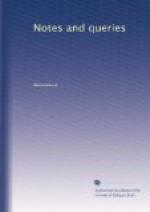SYMBOLS OF THE FOUR EVANGELISTS.
Horne, in his Introduction, vol. iv. p. 254., says that Irenaeus was the first to discover the analogy between the four animals mentioned by Ezekiel (i. 5. 10.) and the four Evangelists, which gave rise to the well-known paintings of these latter. He quotes from Iren. adv. Hoer. lib. iii. cap. 11.:—
“The first living creature,
which is like a lion, signifies
Christ’s efficacy, principality,
and regality, viz. John; the
second, like a calf, denotes
His sacerdotal order, viz. Luke;
the third, having as it were,
a man’s face, describes His
coming in the flesh as man,
viz. Matthew; and the fourth, like
a flying eagle, manifests
the grace of the Spirit flying into
the Church, viz.
Mark.”
There is also an interesting passage in Dionys
Carthus. in Apocal. Enarr. iv. 7., from which
the following is an extract:—
“Although the above exposition of Gregorius, in which by the man in meant Matthew, by the calf Luke, &c., be the common one, yet other holy men have held a different opinion, for as Bede relates on this point, Augustine understood by the lion Matthew, because in the beginning of his Gospel he describes the royal descent of Christ; by the calf he also understood Luke, because he wrote of the priestly descent of Our Lord; by the man Mark, because he omits the question of Christ’s birth, and confines himself more especially to describing His acts as a man; by the eagle, all understand John, on account of the sublimity to which his Gospel soars. Others again understand by the lion Matthew; by the calf Mark, on account of the simplicity of his style; and by the man Luke, because he has more fully treated of Christ’s human generation.”
Would “JARLZBERG” kindly favour me with a reference to his interesting anecdote of the lion’s whelps?
J. EASTWOOD.
Ecclesfield, May 9. 1850.
* * * * *
Your correspondent “JARLZBERG” (No. 24. p. 385.) inquires for the origin of the Evangelistic symbols. The four living creatures, in Ezekiel, i. 10., and Revelations, iv. 7., were interpreted from the earliest times to represent the four Gospels. Why the angel is attributed to St. Matthew, the lion to St. Mark, and so on, is another question: but their order in Ezekiel corresponds with the order of the Gospels as we have them. Durandus would probably furnish some information. The fabulous legend of the lion savours of a later origin. Some valuable remarks on the subject, and a list of references to early writers, will be found in Dr. Wordsworth’s Lectures on the Canon of Scripture (Lect. VI. p. 151.), and his Lectures on the Apocalypse (Lect. IV. pp. 116, 117.)
C.R.M.
* * * * *
Symbols of the Evangelists (No. 24. p. 385.).—The symbols of the four Evangelists are treated of by J. Williams, Thoughts on the Study of the Gospels, p. 5—22. Lond. 1842.




